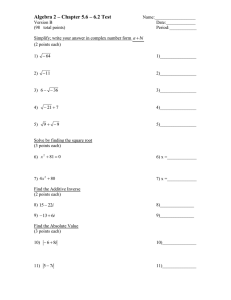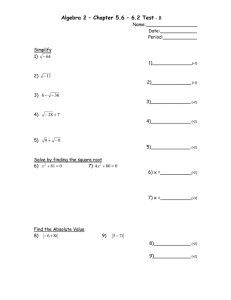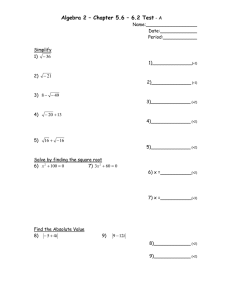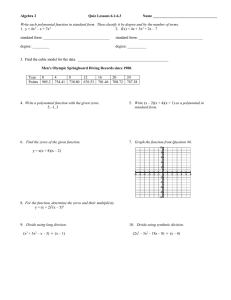4.4 The Fundamental Theorem of Algebra
advertisement
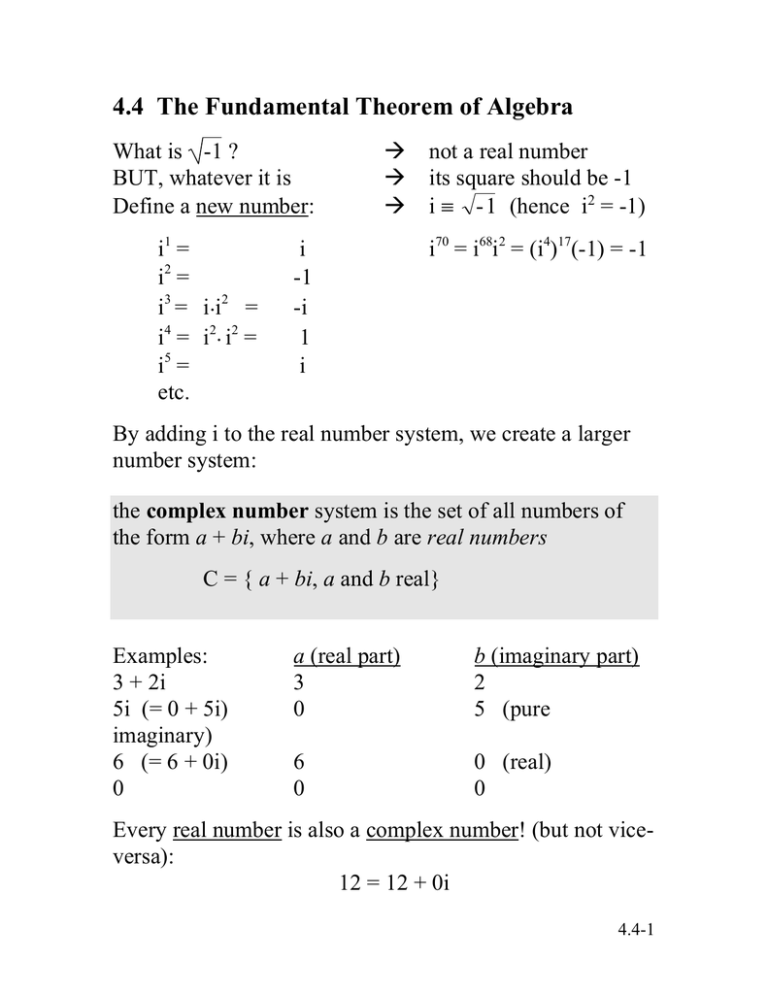
4.4 The Fundamental Theorem of Algebra
What is -1 ?
BUT, whatever it is
Define a new number:
i1 =
i2 =
i3 = i. i2 =
i4 = i2. i2 =
i5 =
etc.
i
-1
-i
1
i
not a real number
its square should be -1
i -1 (hence i2 = -1)
i70 = i68i2 = (i4)17(-1) = -1
By adding i to the real number system, we create a larger
number system:
the complex number system is the set of all numbers of
the form a + bi, where a and b are real numbers
C = { a + bi, a and b real}
Examples:
3 + 2i
5i (= 0 + 5i)
imaginary)
6 (= 6 + 0i)
0
a (real part)
3
0
b (imaginary part)
2
5 (pure
6
0
0 (real)
0
Every real number is also a complex number! (but not viceversa):
12 = 12 + 0i
4.4-1
Operations on complex numbers
Easy!
think of i as a "variable"
use all the laws we already know to do the computation
reduce any powers of i that you get
write the final answer in standard form: a + bi
(1 + 2i) + (2 - 3i)
(1 + 2i)(2 + 3i)
=3-i
= (by FOIL) 2 + 7i + 6i2 = -4 + 7i
Division trick: to do
1 + 2i
2 - 3i
, do the following:
(1 + 2i) . (2 + 3i)
(2 - 3i) (2 + 3i)
(multiply numerator and denominator by complex
conjugate of denominator)
=
- 4 + 7i
2 2 - 9i 2
=
- 4 + 7i
= -4/13 + (7/13)i
13
Notes:
conjugate of 20i is -20i
the square root of a negative can be written using i:
- 7 = -1 7 = i 7
always turn square root of a negative into imaginary
before you do any computing:
( - 3 )2 = (i 3 )2 = i2( 3 )2 = -3
( - 3 )2 = - 3 - 3 = 9 = 3
YES
NO
4.4-2
FUNDAMENTAL THEOREM OF ALGEBRA
All zeroes of all polynomials with real or
imaginary coefficients are complex numbers
or, to put it another way
LINEAR FACTORIZATION THEOREM
Any polynomial
f(x) = anxn + . . . a1x + a0
(degree n)
can be factored (by repeated division) into n linear factors:
f(x) = an(x - c1)(x - c2) . . . (x - cn)
where the ci’s are complex numbers.
Constructing a polynomial having given zeros
Easy! If given zeros are 3, -2, -i and i, and the leading
coefficient is -2, the polynomial
f(x) = -2(x - 3)(x +2)(x - i)(x + i)
will clearly do the trick!
If you have to multiply it out, multiply these two factors first:
(x - i)(x + i) = x2 - i2 = x2 + 1
getting rid of the presence of i in subsequent multiplications
4.4-3
Conjugate Zeros Theorem
If a polynomial with real coefficients has a zero a + bi,
it also has a zero a - bi, and vice-versa.
Imaginary zeros for such polynomials
always occur in complex conjugate pairs.
reason? think about x2 - 2x + 2
zeros are the roots of x2 - 2x + 2 = 0
2 4
quadratic formula gives us:
= 1i
2
it's the in the quadratic formula that gives us the
complex conjugate pairs.
Exercise: Construct a cubic polynomial f with real
coefficients two of whose zeros are 3 and 2 + i.
Since it has real coefficients, it must also have 2 - i as a
zero.
F(x) = (x - 3)(x - (2 + i))(x - (2 - i)) This is the solution. If
you are asked to multiply it out, do this:
(x - 3)(x - 2 - i)(x - 2 + i) = (x - 3) ((x - 2) - i)((x - 2) + i)
= (x - 3)( (x - 2)2 – i2 )
[(a – b)(a + b) = a2 – b2 ]
= (x – 3)((x – 2)2 + 1)
Now you can finish it without having to deal with i’s.
4.4-4
